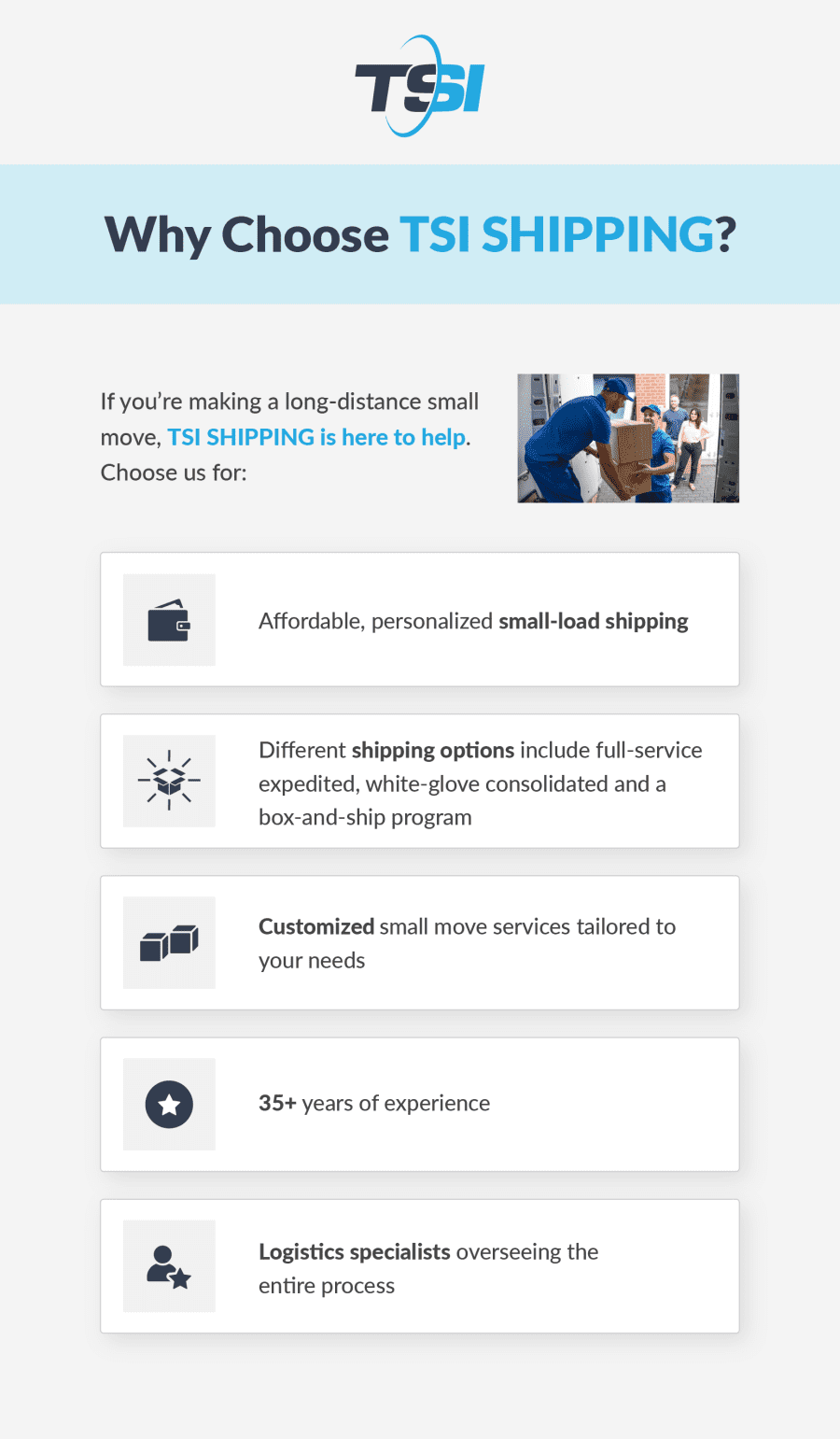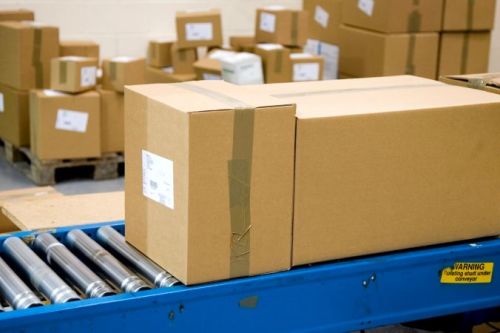TSI is happy to provide you with information related to shipping and moving. If and when you’d like more details for shipping your boxes, you can request a quote or call us at 1-800-626-1257. We’ve been leading the way in small moves and specialty shipments nationally for more than 30 years and are A+ rated by the Better Business Bureau.
Calculating shipping costs and choosing the most economical shipping method can be confusing. Our Cheapest Way to Ship Anything guides make it easy to compare shipping costs and choose the right method for your cargo, whether you're shipping common items like boxes or difficult-to-transport goods like antiques or artwork.
Jump to:
1. How Much Does it Cost to Ship Large Boxes?
We've calculated shipping costs for three common shipping methods: USPS, parcel shipping, and consolidated freight.
i. USPS shipping costs
ii. Parcel shipping costs (eg. UPS or FedEx)
iii. Consolidated freight
2. Frequently Asked Questions
Get answers to the most frequently asked questions about shipping large boxes.
Mailing or shipping small boxes and parcels is often straightforward—most of the time, you can simply drop them off at your local post office or courier. Shipping large boxes, however, can be a little more complicated. Every carrier defines “large box” differently, and USPS and courier services like FedEx® and UPS® have strict weight and size limits and can quickly become too costly for large packages, especially if your boxes are also heavy or if they are travelling a long distance.
There are many reasons why you might need to ship large boxes, such as:
- Business owners sending large boxes to customers, the next step in your supply chain, or another location in your network.
- Homeowners shipping large boxes as part of a household move, including small apartment moves, college moves, estate distributions, and full household moves.
Whether you’re a business owner or a homeowner, there are a number of special considerations to keep in mind when shipping large boxes:
- Box size: Every carrier defines “large box” differently. Generally, a large box is about the size of a large suitcase. The most common large box size is 18” x 18” x 24”, but larger sizes are also available. The box you choose should be slightly larger than what you are packing or shipping to allow enough space to pack your items in a way that will prevent shifting and breakage. However, your box should not be so large that you end up paying higher shipping costs than you need to.
- Accurate measurements: Always measure your boxes before shipping—especially if you’re shipping large boxes—to avoid incurring any unexpected oversized package charges.
Need help shipping heavy items?
Take a look at our furniture shipping solutions page. Getting a price is easy, simple and straightforward.

How to measure a large box
- Measure the longest side—this is the length.
- Measure the thickest part—this is the girth.
- Add the length and girth to get the total measurement.
Length + girth = Total size of box
- Box weight: Large boxes should be packed full but not heavy. Ideally, large boxes will not exceed 50 lbs so they can be moved easily without risk of injury or damage, especially if you’ll need to transport them to the post office or parcel depot, load them into a moving vehicle, or carry them to the curbside for freight pickup.
- Dimensional weight: Dimensional weight is a pricing technique used in freight transport, typically for large light packages. Your package will be priced based on an estimated weight that’s calculated based on its length, width, and height to account for the density of your cargo. Large, light packages are more likely to be subject to dimensional weight pricing.
- Box contents: Whatever you’re transporting, it’s important that it’s packed properly to prevent shifting or damage from impact. Large boxes are ideal for packing light items so they are easy to carry, while bulky but heavy items are typically best packed into smaller boxes.
- Proper packing: Packing a large box too full increases the chance of damage to the contents. Overstuffed boxes are more likely to burst in transit, and there’s also a greater likelihood they’ll be packed too heavy, which can increase your shipping costs.

How much does it cost to ship large boxes?
The cheapest way to ship large boxes depends on the exact size of the box, and for some providers, the speed and distance it will travel. For single boxes, USPS is often the cheapest option. For large light boxes, USPS Priority Mail will be the cheapest. For heavy large boxes or shipments of multiple boxes, consolidated freight is one of the most cost-effective shipping methods.
Compare rates for shipping flat rate boxes using the most common shipping methods:
- USPS
- Parcel shipping (such as FedEx or UPS)
- Consolidated freight
USPS
The United States Postal Service can transport large boxes using Priority Mail shipping, as well as Priority Mail Express and Retail Ground.
For flat rate shipping, USPS sells two sizes of large boxes:
- 23 11/16” x 11 ¾” x 12”
- 12” x 12” x 5 ½”
Cartons up to 20” x 14” x 10” are also available, but must be shipped using variable pricing. If you want to use your own box, you’ll also need to ship your package using variable pricing. Three variably priced service levels are available for shipping large boxes:
- Priority Mail: Ships in 1-3 business days, depending on origin and destination. Packages must be under 70 lbs and less than 108” in length and 165” in girth.
- Priority Mail Express: Ships in 1-2 business days with overnight delivery available. Packages must be under 70 lbs and less than 108” in length and 165” in girth.
- Retail Ground: Ideal for less urgent deliveries and packages too large for Priority Mail or Priority Mail Express. Packages must be under 70 lbs, but can be up to 130” in combined length and girth and may be subject to oversized pricing.
Large, light packages will always be subject to oversized pricing. Dimensional weight charges will apply to all boxes exceeding 1 cubic foot, with exact postage dependent on whichever charge is higher (actual weight vs. dimensional weight).
With variable pricing, your final shipping cost will depend on the size and weight of your package, as well as the speed and distance of travel.
Parcel shipping services like UPS and FedEx will accept large packages up to 150 lbs with the same measurements as USPS—up to 108” long or 165” in combined length and girth.
The cost of your shipment will depend on the level of service you choose, as well as the distance your package will travel. Large packages that qualify will be subject to oversized pricing, and large, light packages will be subject to dimensional weight pricing to account for the bulk of the package in addition to its weight.
UPS and FedEx both offer flat rate and variable pricing options. Both carriers can transport packages up to 50 lbs, regardless of box size—that means you’ll pay the same flat rate for a large, light package as you’ll pay for the same-sized package weighing 50 lbs.
For UPS flat rate shipping, called UPS Simple Rate, you must supply your own boxes. Box sizes and flat rate pricing are determined by box volume. Two large sizes are available:
- Large: 651-1,050”3
- Extra large: 1,051-1,728”3
Additional surcharges will apply for packages that require a signature or delivery confirmation. For FedEx flat rate shipping, called FedEx One Rate, you must use FedEx boxes. Four large box sizes are available:
- Large: 12 ⅜” x 3” x 17 ½” or 8 ¾” x 7 ¾” x 11 ¼”
- Extra large: 11 ⅞” x 10 ¾” x 11” or 15 ¾” x 14 ⅛” x 6”
FedEx One Rate shipments are priced based on the distance travelled as well as the speed of travel. If you need to ship an even larger box, FedEx also offers a flat rate pricing option for less-than-truckload (LTL) shipments up to 1,200 lbs. Two box sizes are available for flat rate freight pricing:
- 48” x 40” x 38” (requires palletization)
- 48” x 40” x 28” (includes integrated pallet)
Shipping costs range from $141 to $349 per box, depending on the distance and speed of travel.
For variable pricing from UPS or FedEx, the cost of your large package shipment will depend on the weight of the item and the distance it will travel—the size of the item doesn’t impact your shipping costs.
Consolidated freight
When you ship your large boxes using consolidated freight, your items will share space on the truck with other items heading in the same direction. The size of your item doesn’t impact your shipping costs until your box reaches 8 feet or more on one side. For packages over 8 feet on one side, an “excessive length” flat fee will be applied. This fee increases for packages exceeding 12’ on one side, and increases again for large boxes exceeding 16’.
Three services are available from consolidated freight shippers:
- Flat rate: Some consolidated freight carriers offer flat rate box shipping services for large boxes. TSI’s flat rate box shipping service includes boxes that measure 18” x 14” x 12”, and boxes must weigh less than 40 lbs when packed. This service is ideal for transporting clothes and linens, books, and other non-valuable household goods. Learn more about flat rate shipping for large boxes with TSI.
- LTL (less-than-truckload): Sometimes called “Economy” shipping, with LTL shipping, you will pack your boxes yourself and help with curbside loading and unloading. LTL shipments have lower prices and faster delivery timelines, and are ideal for items that are not overly fragile or valuable.
- White Glove: This service includes indoor pickup and delivery as well as professional packing services. It’s more expensive with longer timelines, and is ideal for fragile or valuable items such as artwork, antiques, and heirloom pieces.
LTL and White Glove services are priced based on variable pricing. What matters most is the weight of your shipment—the size of your box doesn’t matter unless it exceeds 8 feet on one side.
Most consolidated freight carriers will have a minimum billable weight. These carriers are capable of carrying lighter cargo, but the cost of your shipment will be based on the minimum billable weight, even if it weighs less. TSI’s minimum billable weight is 120 lbs.

COVID-19 Precautions
TSI is carefully monitoring all of our shipments nationwide. We have seen minimal delays thus far, and are in constant contact with transportation industry leaders in order to be as proactive as possible. All members of the logistics chain are using the safety precautions recommended by the C.D.C.:
- Clean your hands often (washing for 20 seconds or using hand sanitizer)
- Avoid touching your face
- Avoid close contact
- Stay home if sick
- Cover coughs and sneezes
- Clean and disinfect frequently touched surface
NOTE: Shipping cost estimates are calculated using individual providers’ online cost estimator tools. Details, exact prices, and shipping times are not guaranteed.

Frequently Asked Questions
What’s the best way to ship large items?
The best way to ship large items depends on the weight of the item.
- Anything under 70 lbs, less than 108” in length, and less than 165” in girth can typically be shipped via USPS
- Packages between 70-150 lbs are often best shipped using courier services
- Anything over 150 lbs or larger than the maximum size permitted by these carriers should be shipped by consolidated freight
What’s the cheapest way to ship an oversized package?
The cheapest way to ship an oversized package depends on the exact size and weight of your cargo and the distance it will travel.
- For packages under 70 lbs, USPS is typically the cheapest option.
- For packages over 70 lbs or deliveries that are not time-sensitive, consolidated freight is one of the most cost-effective shipping methods for oversized packages.
Learn more about the cheapest way to ship oversized packages.
What’s the best way to ship large heavy items?
The best way to ship heavy items over 150 lbs is through consolidated freight shipping like less-than-truckload (LTL) or white glove shipping.
Consolidated freight carriers don’t use the same systems as parcel carriers, and have more flexibility and freedom to customize your shipping plan without a maximum weight limit or additional surcharges for heavy items.
How can I ship several large boxes?
The best way to ship several large boxes is to palletize your boxes. This way, your boxes will be easier to load and unload, and there will be significantly less chance of your shipment getting lost or damaged in transit.
Some shipping providers, including TSI, offer custom palletization services for an additional fee.
What is the biggest box USPS will ship?
The biggest box USPS will ship using standard mail services can be up to 108” in combined length and girth. Packages up to 130” in combined length and girth will be subject to oversized pricing and must be shipped via Retail Ground.
The largest box USPS will ship using flat rate pricing is 23 11/16” x 11 ¾” x 12” or 12” 12” x 5 ½”.
How do I pack a large box?
To pack a large box, follow these steps:
- Assemble the box and line with padding. Crumpled newspaper or magazine pages can work for household moves, but large bubble wrap or packing paper is typically the best choice, especially for retailers. Do not use packing peanuts—they’ll shift around inside the box in transit, and they aren’t environmentally friendly.
- Wrap items individually in packing paper or bubble wrap, especially if you’re packing fragile items.
- Load heavy items into the box first and pack lighter items on top with sufficient padding between each layer, as well as around the outside edge of the box.
- Seal the box, taking care to seal each seam using high-quality packing tape.
- Label the box according to your shipper’s requirements, especially if it’s heavy.


